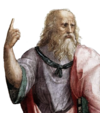观念论
此条目目前正依照其他维基百科上的内容进行翻译。 (2020年7月10日) |
| 系列部分之 |
| 柏拉图主义 |
|---|
 |
| 相关条目 |
| 相关分类 |
观念论或理型论[注 1](英语:idealism,德语:Idealismus,又作theory of Forms 形式理论, theory of Ideas等),是希腊哲学中的一种古老的世界观和理论,是抽象化世界观在西方的开始,由柏拉图总结并论述。近现代学者依据理解不同将其归类于本体论或知识论的范畴。所谓“理型”或称“理念”(Form, Ideas)可直译为“可见形态”、“外貌”(参见下文中词源一节),在柏拉图的理论中指代一种超出自然现象与时间的绝对、不可移存在,而自然存在的物质不过是理型的“近似物”而已[2]。
根据该理论,理型被视作切实存在的实体,而就本体论的层面而言,理型同时也优于感官感受到的现实存在。举例来说,“美丽本身”、“正义本身”、“圆本身”、“人类本身”之类的观念,用理型论的视角看待,不仅只是人类感官知觉到的某种表象,更是客观存在的超验实体。所谓理型并不是感官的感受,而是切实存在的事物,除此之外,它们还是完美的、永恒的。理型是经由易变的感官所观察到的事物原型,也是其得以存在的先决条件。
柏拉图在对话录中并未以本人的口吻论述理型,而是借助了他笔下包括苏格拉底在内的角色来探讨理型的存在,认为只有对理型的研究才能带来知识。然而对于理型论的具体内容学界从未达成共识,而这一辩论至今仍在进行。
语源
[编辑]“理型”一词译自古希腊语 εἶδος(eîdos)、ἰδέα(idéa),但在古希腊语中并非专门创造的哲学术语,而是日常语言的一部分,代表事物的“外貌”与“可见形态”[3]。这两个词的语源都是动词不定式 ἰδεῖν,代表“看”;来自原始印欧语词根 *u(e)id- “看、知”(同源词包括拉丁语 videō)[4]。然而,柏拉图将这两个词的本来含义逆转过来,将“可见形态”变成了无法在自然中看到的一种存在;如果说柏拉图认为人可以“看到”理型,那么这种“看”并不是感官在物质世界中所见,而是一种灵魂的、精神的观察。“以灵魂、精神观察理型”这一思想在柏拉图哲学中占有中心地位[5]。
形式(Form)
[编辑]形式出现于柏拉图对话录与演讲中,认为现实中的每个个物或性质都有其独特的理型存在,举例来说:“狗”有“狗的形式”、山有“山的形式”而“善”有“善的形式”存在。[6]万物在本质上都是各种不同的形式,而人在现实中所看到“现象”(Phenomena)仅仅只是一种类似于理型的阴影;换句话说,现象只是在不同的情况下对于理型的描绘,而非事物的理型本身。理型也是事物的核心概念或称本质,举例来说:世界上有无数张桌子,而所有的桌子都共享桌子的“理型”作为其核心,当没有理型时事物便不存在。
同时,相对于现实事物的易变、生灭,理型论中的理型是一种永恒、完美且无条件的存在,且存在于一个相对于现实世界的“理型世界”之中,当人的灵魂处在轮回阶段且尚未进入肉体前,就是存在于理型世界中了解现实中不同事物的理型(参见“回忆说”),当降生到人世间后才开始回忆、临摹完美的理型。除此之外,理型亦为非空间性(aspatial)、非时间性(atemporal),亦即超出空间、超出时间,因为在柏拉图世界中,理型并非被时间与空间所规范,因此没有所谓时间意义上的的开始与终结,也没有空间维度、方向与位置。相反地,理型提供了时间与空间本身存在的基础,而在现实界之中,理型甚至超越物质与心灵。[7][8][9][10]
注释
[编辑]引用
[编辑]- ^ Diogenes Laertius, 3.15.. [2020-07-10]. (原始内容存档于2014-04-28).
- ^ Watt, Stephen. "Introduction: The Theory of Forms (Books 5-7)". Plato: Republic. London: Wordsworth Editions. 1997: xiv–xvi. ISBN 1-85326-483-0.
- ^ εἶδος in Liddell and Scott; ἰδέα in Liddell and Scott.
- ^ Robert Beekes. Etymological Dictionary of Greek, Vol. 1. Leiden: Brill. 2010: 577. ISBN 978-90-04-17420-7.
- ^ Christian Schäfer: Idee/Form/Gestalt/Wesen. In: Christian Schäfer (Hrsg.): Platon-Lexikon, Darmstadt 2007, S. 157–165, hier: 159–161.
- ^ Baofu, Peter (2011). Beyond Ethics to PostEthics: A Preface to a New Theory of Morality and Immorality. Charlotte, NC: IAP. p. 131. ISBN 978-1-61735-311-6.
- ^ Mammino, Liliana; Ceresoli, Davide; Maruani, Jean; Brändas, Erkki (2020). Advances in Quantum Systems in Chemistry, Physics, and Biology: Selected Proceedings of QSCP-XXIII (Kruger Park, South Africa, September 2018). Cham, Switzerland: Springer Nature. p. 355. ISBN 978-3-030-34940-0.
- ^ The creation of the universe is the creation of time: "For there were no days and nights and months and years ... but when he (God) constructed the heaven he created them also." – Timaeus, paragraph 37. For the creation God used "the pattern of the unchangeable," which is "that which is eternal." – paragraph 29. Therefore "eternal" – to aïdion, "the everlasting" – as applied to Form means atemporal.
- ^ Space answers to matter, the place-holder of form: "... and there is a third nature (besides Form and form), which is space (chōros), and is eternal (aei "always", certainly not atemporal), and admits not of destruction and provides a home for all created things ... we say of all existence that it must of necessity be in some place and occupy space ...." – Timaeus, paragraph 52. Some readers will have long since remembered that in Aristotle time and space are accidental forms. Plato does not make this distinction and concerns himself mainly with essential form. In Plato, if time and space were admitted to be form, time would be atemporal and space aspatial.
- ^ These terms produced with the English prefix a- are not ancient. For the usage refer to They are however customary terms of modern metaphysics; for example, see and see
